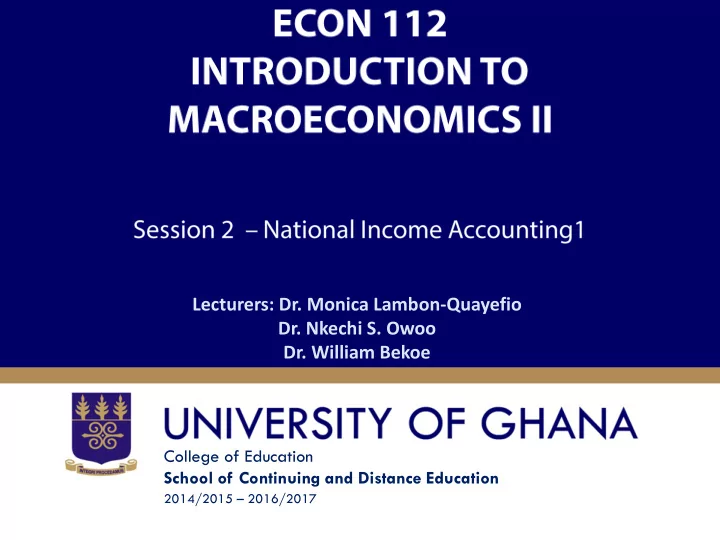

Lecturers: Dr. Monica Lambon-Quayefio Dr. Nkechi S. Owoo Dr. William Bekoe College of Education School of Continuing and Distance Education 2014/2015 – 2016/2017
Session Overview • This session introduces students to one of the very important statistics that economists use to monitor the performance of an economy- Gross Domestic Product (GDP)/ National Income. This session provides students with an understanding of the various measurements and components of Gross Domestic Product. – Goals and Objectives • At the end of the session, the student will – Identify the components of national income/GDP – Be able to describe the three main approaches to national income accounting Slide 2
Reading List • Refer to students to relevant text/chapter or reading materials you will make available on Sakai Slide 3
Components: National Income/GDP • The National Income identity equates the national with its components. Using the expenditure approach, the components of national income or GDP are given by the relationship • Y = C + I + G + NX • Y = GDP • C = consumption • I = investment • G = government purchases • NX = net exports Slide 4
Components: Consumption (C) • Consumption, C is spending by households on goods and services. • Consumption is the largest, making up about 70% of GDP. It is the most important component of GDP and it is the obvious way through which income received by households is returned to firms. • Includes estimations for – Food - self-produced and consumed – Rent - owner-occupied homes • Excludes estimation for – Used goods – Assets (stocks, bonds, land) – Newly constructed homes Slide 5
Components: Gross Private Investment (I) • Gross Private Investment refers to businesses spending on the capital equipment, inventories and structures including purchases on new housing. – It also includes inventory accumulation which refers to goods that have been produced but not yet sold. • Gross Private Investment excludes expenditure on government investment, consumer durables and human capital investment. – Gross Private Investment also Ignores depreciation Slide 6
Components: Government Expenditure ( G) • When individuals pay taxes, those taxes are spent by government on consumption goods and services and on gross investment. This is referred to as government expenditure. – Government expenditure may occur at the local level ( district, region) or national level • Government expenditure does not include transfer payments. – Transfer payments are money redistributed from one group of citizens (taxpayers) to another (the poor, the unemployed, the elderly) Slide 7
Components: Net Exports (N-X) • Net Exports is defined as total exports minus total imports. – Net exports, NX = Exports – Imports • Exports refer to spending on domestically produced goods by foreigners. • Imports refer to spending on foreign goods by domestic residents or citizens. Slide 8
Approaches: NI /GDP Measurement • There are three main approaches to measuring National Income. These are – Product or Value Added Approach • GDP = Sum of value added by all firms – Expenditure Approach • GDP = C + I + G + NX – Income/ Factor Payment Approach • GDP = Wages and Salaries + interest + rent + profit • Therefore Total Output= Total Income Slide 9
Approaches: Value-added Approach • In measuring GDP which is the value of all final goods and services produced in a particular year, we must avoid counting intermediate goods and transfer payments in order to avoid double counting. • To avoid counting intermediate goods, the value added approach is used. • The diagram on the next slide shows how the value-added approach is applied. Slide 10
Approaches: Value-added Approach Production Generated Added Farmer harvest wheat $100 $100 Miller makes into flour 200 100 Baker makes into bread 300 100 $600 $300 This is the same as the “value - GDP counts only the final $ value of added.” the final good Slide 11
Explaining the diagram • The farmer produced the wheat and sold it at the market for $100. So his value added is $100. • The miller who bought the wheat from the farmer produced the flour and generated $200. This means in processing the wheat into flour, the value added is $100. • The baker who used the flour produced by the miller to bake bread generated $300. This means that the baker added a value of $100. • The total value of the baker’s product, which includes inputs from the farmer and the miller is what is counted as the final value which equals the value added by each of these players ( the farmer, miller and baker) Slide 12
Approaches: Expenditure • Expenditure approach divides output into four categories according to which group in the economy purchases it as final users – Consumption goods and services (C) — purchased by households – Private investment goods and services (I) — purchased by businesses – Government goods and services (G) — purchased by government agencies – Net exports (NX) — purchased by foreigners • When we add up the purchases of all four groups we get GDP. • GDP = C + I + G + NX Slide 13
Approaches: Income/ Factor Payment • This approach measures the sum of income paid to the factors of production owned by the households by firms. • The factor payments made include payments to owners of resources that are used in the production of goods and services in the form of wages and salaries to labour, interest and profit on capital and rent on land. • Value added by a firm = Total factor payments made by that firm Slide 14
Trial Questions for Self Assessment • Please refer to Trial Questions Folder on Sakai to access the trial questions for this session Slide 15
Recommend
More recommend